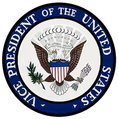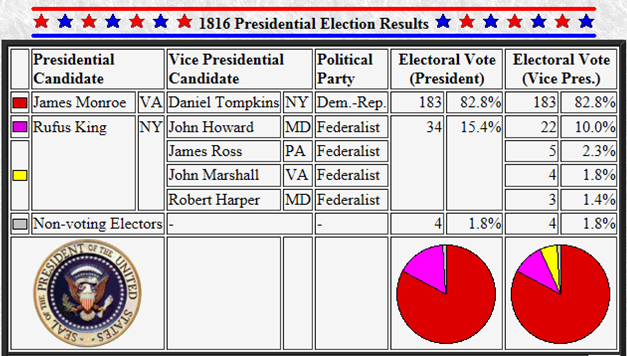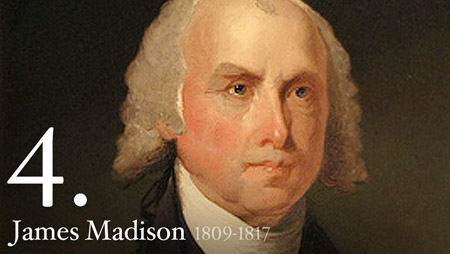Scramblin' thru... the U.S. Presidents
"Mr. Era of Good Feelings"
"The Last Cocked Hat"
"The Daddy of the Doctrine"
"Steamboat Monroe"
Personal Information
|
Level: Some college
(Started at William & Mary but dropped out to join Army; never returned) |
Married: Once
(Elizabeth, 1786) |
Biological Kids: 3
|
|
Wrote:
2 books |
Career BEFORE Presidency:
soldier, lawyer, U.S. Senator, Governor of Virginia |
Career AFTER Presidency:
writer, Regent at University of Virginia |
Presidential Information
Election Information
Election of 1816
Election of 1820
A Presidential Life in Review
|
James Monroe, the 5th U.S. President from 1817 to 1825, oversaw major westward expansion and strengthened American foreign policy with his self-titled Monroe Doctrine, a warning to Europe to stay out of the Western Hemisphere. Monroe, a Virginia native, fought with the Continental Army in the American Revolution, then served as a U.S. Senator, Governor of Virginia, and Minister to France and Britain. Monroe's Presidency ushered in the "Era of Good Feelings". The U.S. had a new sense of confidence following the War of 1812 and enjoyed political peace thanks to the collapse of the Federalist Party, leaving only Monroe's Democratic-Republicans to run the show. As President, he dealt with the divisive issue of slavery in the new states joining the Union with the 1820 Missouri Compromise. In 1825, Monroe left office and returned to Virginia. He died on July 4, 1831, exactly five years after the deaths of Jefferson and Adams. Source: The History Channel
|
Historical Rankings
Click here to learn more about the C-SPAN Survey
James Madison Fun Facts
Monroe was the first President to ride on a steamboat.
In 1823, Monroe issued the Monroe Doctrine, warning European powers not to interfere with the U.S. and affairs in the Western Hemisphere. In return, the U.S. agreed to stay out of Europe's affairs. (Good thing the U.S. didn't keep its word, eh, Europe?)
Monroe was the first U.S. President to have been a U.S. Senator before becoming President. He served in the U.S. Senate and represented the state of Virginia.
Seventeen U.S. Presidents did not have middle names. Monroe was one of them.
In the Election of 1820, Monroe received every Electoral Vote except one (231-1). The sole vote against Monroe came from William Plumer, an Elector from New Hampshire. Plumer cast his Electoral ballot for Secretary of State John Quincy Adams (who wasn't even running). Historians debate why he did this. Some argue Plumer wanted George Washington to be the only President elected unanimously. Others say Plumer simply thought Monroe was a "mediocre President" and that Adams would be a better one.
Monroe is regarded as the last U.S. President who was a Revolutionary War veteran, since he served as an officer of the Continental Army and took part in combat. He served with distinction at the Battle of Trenton, where he was shot in his left shoulder. (There were only four casualties for the Americans in that entire battle.) He spent three months recuperating from his wound. In the famous painting, Washington Crossing the Delaware, Monroe is depicted holding the flag.
In June 1817, two and a half months after he took office, Monroe embarked on a "Goodwill Tour" of the U.S. Paying expenses out of his own pocket, the new President was greeted by cheering crowds and treated to celebratory picnics, dinners, and receptions in every city he visited. After touring New York, Philadelphia, and Baltimore, Monroe stopped in Boston, where a newspaper hailed his visit as the beginning of an "ERA OF GOOD FEELINGS!"
Monroe's inauguration in 1817 was the first to be held outdoors.
The bride in the first White House wedding was Monroe's daughter. On March 8, 1820, Maria Hester Monroe married Samuel Gouverneur... her cousin.
The U.S. Marine Band played at Monroe's inauguration in 1821 and has done so at every inauguration since.
The University of Virginia stands on land purchased in 1788 from Monroe. The farmland just outside Charlottesville was purchased from Monroe by the Board of Visitors as Central College in 1817. Guided by Thomas Jefferson, the school laid its first building's cornerstone in late 1817, and the Commonwealth of Virginia chartered the new university on January 25, 1819.
Monroe was the first President to live in the White House when it was actually white. The White House was constructed of gray-colored sandstone. The sandstone walls weren't painted white until the White House was reconstructed after the British torched it during the War of 1812. It took 570 gallons of white paint to cover the entire White House.
Monroe is the only U.S. President to have a foreign capital named after him. "Monrovia" is the capital of the African nation of Liberia.
Monroe was the last President who still dressed in the 18th Century fashion of powdered whigs and knee breeches. This resulted in his nickname of "The Last Cocked Hat".
Monroe never finished his college degree. He had started at the College of William and Mary but dropped out in 1775 to join the Continental Army at the start of the American Revolution. Afterwards, he studied law under Thomas Jefferson, hoping to use his training as a means of entering politics. It worked. He entered the Virginia House of Delegates in 1782 and was elected to the Continental Congress the following year.
Monroe died on July 4, 1831, becoming the third President to die on Independence Day. His death came 55 years after independence was proclaimed and five years after the death of two other Founding Fathers who became Presidents, John Adams and Thomas Jefferson. Spoooooooooky...
































































